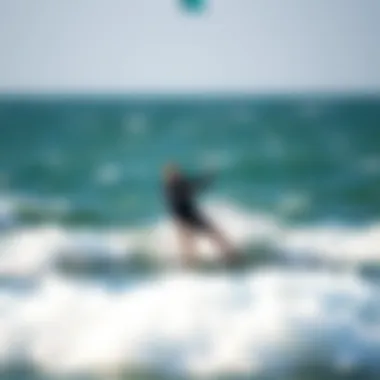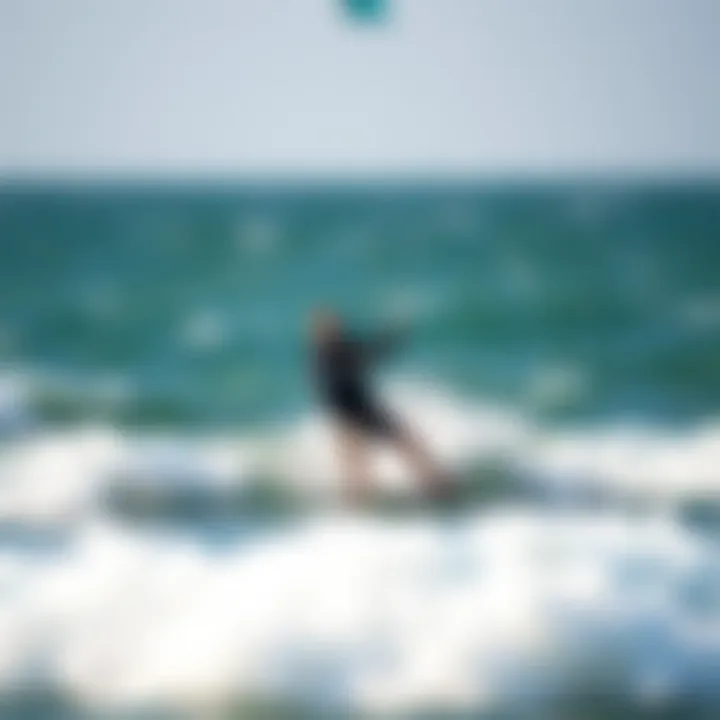Exploring the Unique Aspects of the Phoenix Kite


Intro
The world of kiteboarding is rich with innovation and passion, and at its heart lies the fascinating Phoenix Kite. This kite stands out as a testament to how design and engineering can elevate the experience on the water. The multifaceted nature of the Phoenix Kite isn't just about gliding on the wind; it's about melding functionality, aesthetics, and cultural relevance into a single piece of equipment.
Many enthusiasts are drawn to kiteboarding not just for the thrill, but for the community that surrounds it. Understanding the nuanced features and optimal conditions for using the Phoenix Kite enhances one's enjoyment and skill on the water. Whether you're a newcomer eager to catch the wind or a seasoned pro aiming to push boundaries, delving into the specifics of this kite can prove invaluable.
In the following sections, we will break down essential gear, delve into riding techniques, and explore how this kite integrates into the broader culture of kiteboarding. We aim to provide insights that resonate with both novice kiteboarders and experienced riders looking to refine their craft.
Gear and Equipment
Essential Kiteboarding Gear for Beginners
Starting out in kiteboarding can feel overwhelming with all the various equipment on the market. However, understanding the basics can set a solid foundation for your kiteboarding journey. Here’s a breakdown of essential gear:
- Kite: The heart of your rig. For beginners, a reliable and stable kite is crucial. The Phoenix Kite is often recommended for its user-friendly design and ease of handling.
- Control Bar: This allows you to steer the kite. A good control bar should be intuitive and comfortable in your hands.
- Harness: You'll need a harness to attach to your control bar, which frees up your arms and shoulders. Choose between waist and seat harnesses based on personal comfort.
- Board: Look for a board that fits your skill level. Beginners often start with larger boards for better stability.
- Safety Gear: Don't skip on a life jacket and helmet, especially as you learn the ropes.
Advanced Equipment for Experienced Riders
As you gain confidence and skill, it may be time to consider upgrading your gear. Experienced riders often benefit from:
- High-Performance Kites: These kites, like the Phoenix Kite, are designed for speed and agility, making them ideal for more advanced maneuvers.
- Expanded Board Selection: Diversifying your board selection allows for a tailored approach based on conditions and riding style.
- Foot Straps/Bindings: Advanced riders often prefer more refined attachment systems for better control during tricks.
Techniques and Tips
Basic Riding Techniques for Newbies
For those just starting, getting a good handle on fundamental techniques is crucial. Here are some basic riding skills:
- Powering Up: Learn to generate power from your kite without overextending. Tipping your kite slightly can help manage this balance.
- Turning: Smoother turns come with practice. Beginners should focus on body positioning to initiate turns without losing speed.
- Stopping: Mastering how to stop effectively helps with safety. Practice maneuvering the kite above you to slow down before landing.
Expert Tricks to Elevate Your Skills
Once you’ve mastered the basics, consider tackling some more advanced techniques. These may include:
- Jumping: Jumping requires precise timing. Begin by loading your back foot and edging upwind before popping off the water.
- Spin Tricks: Adding spins to your jumps can elevate your style. Start with simple 180-degree turns before progressing to more complex rotations.
- Wave Riding: For those fortunate enough to ride in surf conditions, perfecting the turn and your positioning can lead to exhilarating rides.
"Kiteboarding is not just a sport; it's a journey of discovery and a deep connection with the elements."
By understanding the gear needed and mastering essential skills, you set yourself up for a fulfilling kiteboarding experience that enhances not just your technique, but also your enjoyment of the sport.
For further information about kiteboarding gear, techniques, and community engagement, you can visit Wikipedia, Britannica, or check out resources on Reddit for community recommendations.
Prologue to the Phoenix Kite
The Phoenix Kite is not merely a piece of equipment; it is a symbol of progress and innovation in the world of kiteboarding. As enthusiasts venture into this thrilling sport, understanding what the Phoenix Kite represents can enhance their overall experience. It's crucial to explore its defining characteristics, historical context, and how it differentiates itself from other kites, providing both practical prowess and artistic flair.
Defining the Phoenix Kite
The Phoenix Kite is a unique kiteboarding design known for its vibrant colors and dynamic shape, resembling the mythical bird from which it takes its name. Characterized by its versatility and adaptability, the kite works seamlessly in various wind conditions, making it suitable for both novices and veterans alike.
Its technical specifications often include a wide wingspan, allowing for greater lift and maneuverability. The design philosophy behind the Phoenix Kite emphasizes not just functionality but also aesthetic appeal. Users are drawn to its striking presence on the water, making it a favorite for those who wish to stand out while enjoying their favorite sport.
"A kite like the Phoenix isn’t just a tool; it’s almost an extension of the rider’s will, reflecting their style and ambition."
Historical Context
To appreciate the Phoenix Kite, one must look back at its origins. The evolution of kiteboarding kites has been influenced by various cultures and technological advancements. The early forms of kites can be traced back thousands of years, with roots in Asian regions where they were often used for military purposes or as tools for fishing.
As the sport of kiteboarding began to take shape in the late 20th century, designers sought to enhance lift, control, and stability through innovation. The Phoenix Kite emerged as a result of continuous experimentation with materials and shapes. From being a simple two-dimensional design, kites evolved into more complex structures thanks to advancements in hydrodynamics and material science. Notably, the introduction of lightweight synthetic fabrics and advanced rigging systems paved the way for the Phoenix Kite's development.
Over the years, the presence of the Phoenix Kite in kiteboarding events has also sparked community discussions around performance standards and personal preferences. Riders increasingly appreciate the balance between technical efficiency and the cultural symbolism of the phoenix itself—resilience, rebirth, and triumph.
In summary, the Phoenix Kite stands at the intersection of tradition and modernity, making it an intriguing topic of exploration for both newcomers and seasoned kiteboarders.
Design Characteristics


The design characteristics of the Phoenix Kite play a crucial role in how it's perceived and utilized within the kiteboarding community. These traits not only dictate its functionality but also influence its aesthetic appeal and overall performance. Understanding these elements brings clarity to both new and seasoned kiteboarders who aim to enhance their riding experience.
Materials Used in Construction
The materials selected for constructing a Phoenix Kite significantly impact its performance, longevity, and responsiveness. Common materials include ripstop nylon for the sail, which is lightweight yet durable, allowing the kite to withstand harsh winds. The frame often features fiberglass or aluminum tubing, providing the necessary stiffness while keeping the overall weight manageable. Some manufacturers even experiment with hybrid materials that fuse both durability and reduced weight, catering to the needs of various skill levels.
When considering construction materials, factors such as UV resistance and tear strength become pivotal. Kites used frequently in bright sunlight need materials that won't degrade quickly. Therefore, choosing a kite with a robust UV-resistant coating is essential for prolonged use.
In addition to performance attributes, the environmental impact of materials is gaining traction. More kite brands are exploring sustainable materials, offering eco-friendly options without compromising quality. This shift reflects a broader trend within the outdoor industry toward sustainability, making it a critical consideration for today’s conscientious kiteboarders.
Shape and Size Variations
The shape and size of a Phoenix Kite can drastically influence its flying characteristics. Generally, kites with a delta shape provide better stability in low wind conditions, making them suitable for beginners. Conversely, more advanced kite designs often adopt a flatter, more elongated shape, which enhances speed and agility during high-speed maneuvers.
Size matters as well. Kites typically range from 5 to 20 square meters, with larger kites catching more wind and thus generating more power. This allows experienced riders to perform daring tricks. However, larger kites might require more skill to control properly, especially in gusty conditions. Choosing the right size according to one’s skill level and local wind conditions is vital. Beginners might feel more comfortable with a smaller kite that’s easier to manage, while experienced riders might gravitate toward larger options for additional lift and speed.
"Selecting the right size kite can be the difference between flying high and crashing hard."
Artistic Features
Artistic features of the Phoenix Kite often make it a standout in the sky. Many designs incorporate vibrant colors and eye-catching patterns, transforming functional equipment into visual art. This not only serves a personal expression but also can increase visibility in the sky, ensuring safety while riding.
Some kite brands have taken inspiration from cultural motifs and local art styles, effectively blending tradition with modern kiteboarding evolution. Personalization has become a trend as riders can modify their kites through custom prints, allowing for individual flair on the water.
Another captivating aspect is the incorporation of LED lights in certain kite designs. This feature elevates night kiteboarding experiences, creating a spectacle of lights darting across the water, captivating both riders and spectators.
For more insights on kite design, visit Wikipedia: Kite or explore discussions on Reddit: Kiteboarding for insights from fellow kiteboarders.
Performance Analysis
The performance of a kite, especially the Phoenix Kite, goes beyond mere speed or height. It's about understanding how the kite interacts with the forces of nature during its flight. When we analyze its performance, we delve into essential elements like wind conditions, stability, and agility. This analysis is not just for show; it serves as a guide for enthusiasts seeking to enhance their kiteboarding experience.
Wind Conditions Suitability
Wind is the lifeblood of kiteboarding. Every kiter knows that the conditions of the breeze can either make or break their day on the water. The Phoenix Kite is designed to excel in various wind scenarios, ranging from light whispers to robust gusts.
- Light Winds: In gentler breezes, the Phoenix holds its own, maintaining lift and responsiveness, crucial for beginner kiteboarders still finding their footing.
- Moderate Winds: As the winds pick up, the kite's large surface area allows for comfortable soaring. Kiteboarders can focus more on maneuvering instead of battling the wind force.
- Strong Winds: The construction of the Phoenix Kite involves durable materials that ensure it can handle tougher conditions without compromising safety or performance. This is vital for experienced kiteboarders who seek the thrill of high-speed runs and jumps.
By assessing wind conditions with the Phoenix, riders can ask themselves: "Am I prepared for the challenges this wind brings?" and �"How can I adapt my style?"
Stability and Control
Stability underlines confidence in the air. The Phoenix Kite boasts a unique design that provides balance and control, allowing riders to feel secure even in tricky situations.
- Wing Shape: The aerodynamically refined form minimizes drag while maximizing lift. This unique structure promotes smoother glides, which can give a rider the sense of flying rather than floundering.
- Control Bar System: The Phoenix incorporates an intuitive control system, making it easier for users to steer seamlessly. New kiteboarders, in particular, often find comfort in the predictable handling of the kite, which can inspire quick learning and confidence.
Whether you’re slicing through waves or catching air, knowing how to handle the kite with stability transforms performance significantly.
Speed and Agility
In kiteboarding, speed is synonymous with exhilaration. But it’s not merely about how fast you can go; it’s also about how responsive the kite feels as you initiate movements.
- Acceleration: The Phoenix Kite’s design ensures quick acceleration, achieving top speeds without causing the rider to feel out of control. You’ve got to feel the wind at your back, but also ensure the kite rides the trails with you.
- Maneuverability: This kite can execute sharp turns and rapid adjustments without losing momentum, which is perfect for riders who enjoy navigating their environment with finesse.
Utilizing the Phoenix Kite, riders can express themselves with bold maneuvers that showcase their skills while still adhering to the essential fundamentals of kiteboarding.
"A good kite lets you harness the wind; a great one makes it feel like your dance partner."
For more information on kiteboarding best practices and gear, check out resources like Wikipedia or Britannica.
Discover community insights on forums like Reddit as you refine your skills and connect with fellow enthusiasts.
Cultural Impact
The cultural influence of the Phoenix Kite in kiteboarding extends beyond mere recreational activity. It embodies a rich tapestry of traditions, identities, and values that resonate within the kiteboarding community. This section explores the dimensions of this phenomenon, revealing why it holds significance for enthusiasts around the globe.
Symbolism of the Phoenix in Kiteboarding


The phoenix, a mythical bird that rises from its ashes, symbolizes rebirth and renewal. In kiteboarding, this symbolism is not just a pretty picture; it reflects the spirit of adventure and continual growth among kiteboarders. The act of flying a Phoenix Kite can be seen as a celebration of overcoming challenges, as kiteboarders often embark on journeys to master new skills or face nature’s elements. The kite itself evokes this imagery. Each flight signifies a personal triumph, a moment where the boarder breaks free from limitations, much like the phoenix soaring into the sky.
Key Symbolic Themes:
- Transformation: Just as the phoenix transforms from ashes into a magnificent being, kiteboarders evolve through practice and perseverance.
- Freedom: The Phoenix Kite embodies the freedom associated with the open skies and vast waters, serving as a reminder of the thrill that lies in exploring the unknown.
- Unity: The phoenix, often depicted in vibrant colors, can signify community bonds. When kiteboarders gather, they create an atmosphere filled with shared experiences, fueling camaraderie amongst different cultures.
Community and Events
Kiteboarding isn’t just about the individual experience; it’s a communal sport that thrives on the interactions between participants. The Phoenix Kite has ushered in a series of events and festivals that strengthen community ties and celebrate this extraordinary kite.
Several global kiteboarding festivals prominently feature the Phoenix Kite, attracting enthusiasts from diverse backgrounds. These events not only showcase impressive skills but often turn into vibrant gatherings where participants swap stories, tips, and laughter.
Notable Events:
- Kiteboarding World Cup: An annual gathering that draws elite kiteboarders, featuring the Phoenix Kite in various competitions.
- Local Family Festivals: Small community events where families gather to experience the joy of kiteboarding, often including activities for all ages, from novice lessons to competitions.
- Workshops and Clinics: These offer hands-on opportunities for kiteboarders, particularly beginners, to learn techniques and safety practices, often centered around the Phoenix Kite’s handling characteristics.
Innovations Inspired by the Phoenix
The Phoenix Kite has spurred not only cultural but also technological innovations in kiteboarding. In response to the unique demands that kiteboarders place on their gear, designers have developed new materials and designs that not only improve performance but also resonate with the kite’s symbolic nature.
Key Innovations:
- Advanced Materials: Use of lightweight yet durable materials allows for better performance and easier handling compared to traditional kites.
- Ergonomic Designs: Kites featuring improved shapes and sizes aimed at optimizing aerodynamics and personal comfort are now becoming more common in today’s market.
- Eco-Friendly Approaches: Many new designs integrate sustainable practices, mirroring the phoenix's theme of rebirth. Companies focus on recyclable materials to minimize environmental impact, which becomes a talking point within the kiteboarding community.
In essence, the Phoenix Kite serves not just as a tool for sport, but as a symbol of growth and innovation within the kiteboarding culture, bringing together enthusiasts, pushing the boundaries of design, and creating a sense of belonging among its users.
Techniques for Handling the Phoenix Kite
When it comes to kiteboarding, mastering the techniques of handling the Phoenix kite is essential. Not only does it enhance the overall experience, but it also ensures safety and efficiency during flight. Understanding these techniques can make the difference between a thrilling ride and a chaotic tumble. Let's delve into two primary aspects—launching and landing, as well as maneuvering in various conditions.
Launching and Landing
Launching and landing a Phoenix kite demands precision and focus. A good launch sets the stage for a successful ride, while a controlled landing is crucial to avoid mishaps. Here are some important elements to consider:
- Wind Direction: Always determine where the wind is blowing from. The kite should ideally be positioned in the proper angle to catch the wind.
- Clear Area: Make sure there is enough space around you. This not only assures that the kite won’t get entangled but also helps in maintaining adequate control.
- Stance: Adopt a relaxed stance. Being tense may disrupt the balance when launching.
When you’re ready to launch:
- Hold the kite at the center with both hands, keeping it steady.
- Have a friend assist you if possible, mainly to help with holding the lines taught.
- Give a controlled pull on the back lines to lift the kite gently into the air. Once it’s airborne, steer it into the desired direction.
Landing requires similar attentiveness:
- Approach with Caution: As you approach land, slowly bring the kite down.
- Cut the Power: Release some tension on the lines to guide the kite gently onto the beach or water.
- Secure the Lines: Once landed, quickly secure your lines to avoid tangling afterward.
"A well-executed launch and landing can be the difference between a great day on the water and a trip to the hospital."
Maneuvering in Various Conditions
Successfully maneuvering the Phoenix kite in different conditions is, without a doubt, a skill learned over time. The kite behaves differently depending on wind speed and other environmental factors:
- Strong Winds: In strong winds, control is key. Lower the angle of the kite to avoid being overpowered. Additionally, keep your weight low and centered to maintain stability.
- Light Winds: For lighter winds, increase the kite's angle by lifting it higher. This will help harness the available wind efficiently.
- Choppy Water: Choppy conditions may challenge even experienced kiteboarders. In such instances, be ready to adjust your center of gravity based on the waves. Staying balanced helps in preventing falls.
- Crosswinds: When dealing with crosswinds, keep the kite lower and be prepared to shift your body position often. This dynamic control can keep you moving smoothly without getting yanked off-balance.
Understanding these situational strategies enhances your ability to adapt and thrive on the water, making every session enjoyable.
Comparative Analysis
Engaging in a comparative analysis when discussing the Phoenix kite is crucial for a few notable reasons. First, it allows us to assess how this kite performs against its traditional counterparts. Understanding the distinctions between the Phoenix kite and other traditional kites helps in identifying the unique capabilities and characteristics that may appeal to kiteboarding enthusiasts. Furthermore, analyzing these differences can inform a potential buyer's decision, as it lays bare the aspects that could elevate their kiteboarding experience.
When exploring the intricacies of the Phoenix kite, we can see that its innovative design offers features that might not be present in conventional kites. This comparative view helps us answer pertinent questions such as:
- What are the unique design characteristics of the Phoenix kite?
- How do performance metrics differ between the Phoenix kite and traditional kites?
- What cultural significance does this kite embody that may give it an edge?
By juxtaposing it with more standard kites, we highlight points of strength, weaknesses, and even the evolving market trends within the kiteboarding culture. In this analysis, kiteboarders from all walks can grasp not only the Phoenix kite's value but also how it stands in relation to what has come before.
Phoenix Kite vs. Traditional Kites


To truly understand the Phoenix kite, we need to draw a clear line between it and traditional kites. The Phoenix kite boasts a aesthetic appeal and functional benefits that often surpass traditional kites. For instance, the materials used in the Phoenix kite's construction are often lighter and more durable. This leads not only to better performance in varying weather conditions but also an easier handling experience.
A key difference also comes in the form of design. While traditional kites may stick to tried-and-true designs, the Phoenix kite often incorporates asymmetrical shapes and unique wing configurations, resulting in:
- Improved lift due to its optimized airflow design
- Enhanced maneuverability, allowing for radical turns and jumps
- Shorter learning curves, making them more appealing to beginners
The essence of the Phoenix lies in its ability to adapt to different conditions while providing a thrilling ride. Traditional kites, while reliable, may not deliver the same exhilaration or versatility. The chase for consistent performance and enjoyable riding experiences is where the Phoenix kite truly shines.
Advantages and Disadvantages
Like any equipment, the Phoenix kite comes with its own set of advantages and disadvantages that every kiteboarder should consider. Here’s a look at both sides of the coin:
Advantages:
- Enhanced Performance: The Phoenix kite’s lighter materials allow for faster speeds and better acceleration.
- Versatility: Adaptable to various wind conditions, it suits both novice and seasoned riders.
- Innovative Designs: The cutting-edge designs not only look good but also function effectively in the air, providing an exhilarating experience.
- Ease of Use: Many users find that the Phoenix kite is more forgiving and easier to control compared to traditional kites.
Disadvantages:
- Cost: Often, the Phoenix kite can carry a higher price tag due to its advanced materials and technology.
- Fragility: While lightness adds to performance, it can also make the kite prone to damage under harsh conditions.
- Steep Learning Curve for Advanced Tricks: Though user-friendly for beginners, mastering its advanced capabilities may require more practice compared to traditional kites.
Recognizing these advantages and disadvantages is essential for anyone considering the Phoenix kite. It emphasizes the idea that the best kite varies significantly from one rider to another, shaped by their skill level, environment, and personal preferences. In essence, the key to choosing the right kite lies not just in performance metrics but in how these factors align with an individual’s style and kiteboarding aspirations.
"A well-informed choice is always a safer choice in the world of kiteboarding."
As we progress through the complexities of kite design, performance metrics, and user experience, it becomes clear that the comparative analysis serves as a crucial foundation in understanding the phenomena surrounding the Phoenix kite. This knowledge empowers not only informed decisions but also a deeper appreciation for the craft and culture of kiteboarding.
Future of the Phoenix Kite
The future of the Phoenix Kite is a captivating subject that highlights the ongoing evolution of kiteboarding, where technology and creativity converge. This section dives into the trends shaping the market and the innovative approaches to kite design. These aspects reveal how the Phoenix Kite may adapt to meet the demands of enthusiasts and new landscapes.
Market Trends and Innovations
In recent years, the kiteboarding market has seen a surge of interest in the Phoenix Kite, fueled by its unique attributes and capabilities. Kiteboarders today are seeking not only performance enhancements but also versatility and artistic expression. Here are some notable trends and innovations:
- Smart Materials: The introduction of reactive fabrics that change properties with wind conditions is a game-changer. These kites automatically adjust to optimize lift and control, making them user-friendly for amateurs while still appealing to seasoned riders.
- Customization and Personalization: Kiteboarding is increasingly a statement of identity. Manufacturers are offering customizable designs, allowing riders to express their style and personality. This tailored approach could revolutionize how kites are marketed and sold, creating a more intimate connection between the rider and their equipment.
- Connected Technologies: Integration of sensors and apps to monitor performance, wind conditions, and environmental factors is on the rise. These tech advancements help kiteboarders make informed decisions in real time, adapting their approach based on data.
The current direction points toward a fusion of artistic innovation and technological functionality, giving birth to kites that not only perform exceptionally but also reflect the rider’s individuality.
Sustainability in Kite Design
As the conversation around sustainability in sports grows louder, kiteboarding is no exception. The future of the Phoenix Kite hinges on incorporating eco-friendly practices into its design and production. Here are some key considerations:
- Material Selection: Manufacturers are actively exploring sustainable materials, such as recycled fibers and biodegradable plastics. Using alternative resources can help reduce the carbon footprint associated with production.
- Longevity and Durability: Kites that are built to last reduce waste. Increased focus on durability can mean fewer kites thrown away and more being repaired or reused. This will not only satisfy eco-conscious consumers but will save money in the long run.
- Community Engagement: Brands are involving the kiteboarding community in their sustainability efforts. Local clean-up events and collaboration with environmental organizations can create a culture of responsibility among riders, positively affecting landscapes where they practice their sport.
The sustainability movement carries significant weight in the future of the Phoenix Kite. Integrating environmental aspects into design and usage will not only contribute to the health of our planet but also resonate with consumers on a deeper level.
In summary, embracing both technological advancements and sustainable practices will be imperative for the Phoenix Kite to thrive in an ever-evolving market.
The trajectory of the Phoenix Kite is not just about soaring higher but also about leaving a lighter footprint on our environment.
Culmination
The phoenix kite stands as a testament to the evolution of kiteboarding—a convergence of art, performance, and cultural significance. As we've navigated through its various attributes, it's clear that the understanding of the phoenix kite extends beyond mere aesthetics or mechanical efficiency. Rather, it represents a blend of tradition and innovation, crucial in shaping the kiteboarding experience.
Summary of Key Points
To distill the essence of our exploration, here are the pivotal points we discussed:
- Definition and Historical Context: Understanding the phoenix kite involves recognizing its unique origins and evolution within the kiteboarding community, merging past traditions with modern designs.
- Design Characteristics: From the materials used, varying shapes, and artistic features, each aspect plays a significant role in the kite's functionality and visual appeal.
- Performance Analysis: The kite's performance metrics—suitable wind conditions, stability, control, speed, and agility—have been highlighted as crucial factors for both novice and experienced kiteboarders.
- Cultural Impact: Symbolically resonant, the phoenix kite has ingrained itself in community events and inspired innovations that push the sport further.
- Handling Techniques: Understanding the nuances of launching, landing, and maneuvering in varying conditions is essential for a seamless kiteboarding experience.
- Future Directions: The discussion on market trends and sustainability points towards an industry poised for growth while being mindful of environmental impacts.
Indeed, these elements underscore the importance of the phoenix kite—not just as an artifact of sport but as a cultural icon that resonates with kiteboarding communities globally.
Final Thoughts on the Phoenix Kite
In contemplating the phoenix kite, one can't ignore its potential to evolve alongside technological advancements. As materials improve and designs become more refined, the exploration of the phoenix kite is bound to continue. Understanding its dynamics offers kiteboarders an edge, enhancing their experience on the water.
Thus, kiteboarding enthusiasts, whether novices or experts, are encouraged to embrace the phoenix kite's multifaceted legacy. It’s more than just a tool for play; it is an extension of self-expression and connection with the elements. In the waves and winds, the phoenix kite invites riders to soar higher, as they become part of a rich tradition that promises to fly into the future.
"The phoenix kite is not merely a means to ride the wind; it symbolizes the spirit of adventure, a bridge between levels of skill and aspiration."
For those looking to delve deeper into the phoenix kite phenomenon, resources such as Wikipedia, Britannica, and various kiteboarding communities on Reddit provide ample knowledge and shared experiences essential for any kiteboarding enthusiast.















